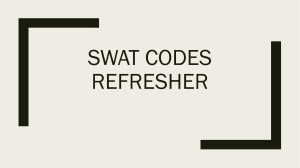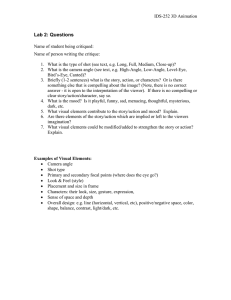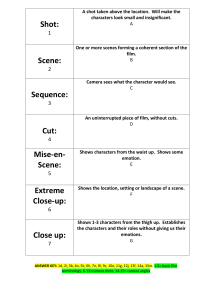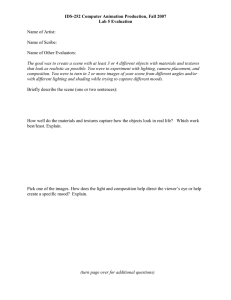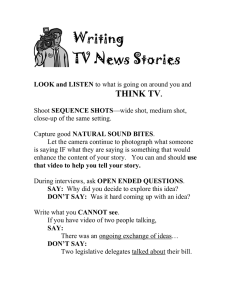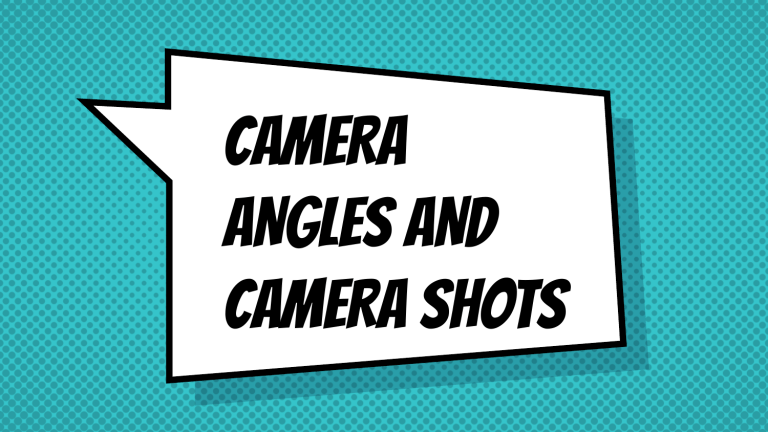
CAMERA ANGLES AND CAMERA SHOTS The way you put the camera can have a big effect on what the picture tells the audience. The angle of a shot can dramatically affect how we perceive the character. The directors in a film choose to use several different angles. The angle of a camera shot is really important for shaping the meaning of the film CLOSE UP SHOT ▪ A close up shot of a character usually takes in their head and shoulders. ▪ It can be used to emphasise how important a character or object is. ▪ It allows the audience to build a relationship with the character 3 EXTREME CLOSE UP SHOT • An extreme close up shot usually focuses on a part of the face (often the eyes or mouth) • Used to convey emotion to the audience • Often used at key points in the story 4 MEDIUM SHOT ▪ A mid shot shows the body from the waist up. ▪ It shows some background and whole body language. ▪ Focus on character – it lets the audience see what they are doing BUT also how they are feeling 5 LONG SHOT ▪ Full body is shown. ▪ Used to show location or relationships of characters. ▪ Often used as a first shot at the start of a particular sequence 6 HIGH ANGLE SHOT ▪ The camera is positioned above the person or place. ▪ It can make a person look vulnerable. ▪ Designed to make the audience side with the characters in shot 7 LOW ANGLE SHOT ▪ The camera is positioned below the person or place. ▪ It can make a person look powerful or important. 8 POINT OF VIEW SHOT ( P.O.V) ▪ The camera becomes the character and shows us exactly what they are seeing, as they would see it. 9 EYE LEVEL ▪ A neutral camera angle ▪ Represents a real person standing up, watching the scene 10 LIGHTING Lighting determines mood. Good lighting will set the mood for any scene in a film, it conveys the plot and creates the atmosphere. A poorly lit film can mislead and leave viewers feeling unfulfilled or confused, just because the lighting needs to represent the genre. KEY LIGHTING × Also known as the main light of a scene or subject × The strongest light in each scene or photo × However, just because it’s your “main” light doesn’t mean it always has to be facing your subject. 12 FILL LIGHTING × This technique is used to “fill in” and remove the dark, shadowy areas that your key light creates × Less intense and placed in the opposite direction of the key light, so you can add more dimension to your scene × The aim of fill lighting is to eliminate shadows 13 BACK LIGHTING × Backlighting is used to create a three-dimensional scene × A back light hits an actor or object from behind, and is usually placed higher than the object it is lighting × A backlight is often used to separate an object or an actor from a dark background, and to give the subject more shape and depth × Backlighting can help bring your subject out and away from looking two dimensional. 14 SIDE LIGHTING × A light that comes from the side parallel to the actor × A sidelight is ideal for creating a dramatic mood 15 HIGH KEY × A style of lighting that is bright and shadowless with lots of fill light × Today high key lighting is primarily used for cosmetic commercials, sitcoms, and music videos 16 LOW KEY × Predominantly dark and filled with more shadows than light × Low key focuses on the use of shadows as a character, rather than the subjects in the light itself × Commonly used throughout horror and thriller films 17 SOUND “Sound” refers to everything we hear in a movie — words, sound effects, and music. Sound is used to heighten a mood, provide us with information about the location of a scene, advance the plot, and tell us about the characters in the story. DIEGETIC SOUND × Refers to all those audio elements that come from sources inside the world we see on the screen, including dialogue, doors slamming, footsteps, etc. 19 NON-DIEGETIC SOUND × refers to all those audio elements that come from outside of the fictional world we see on screen 20 21
